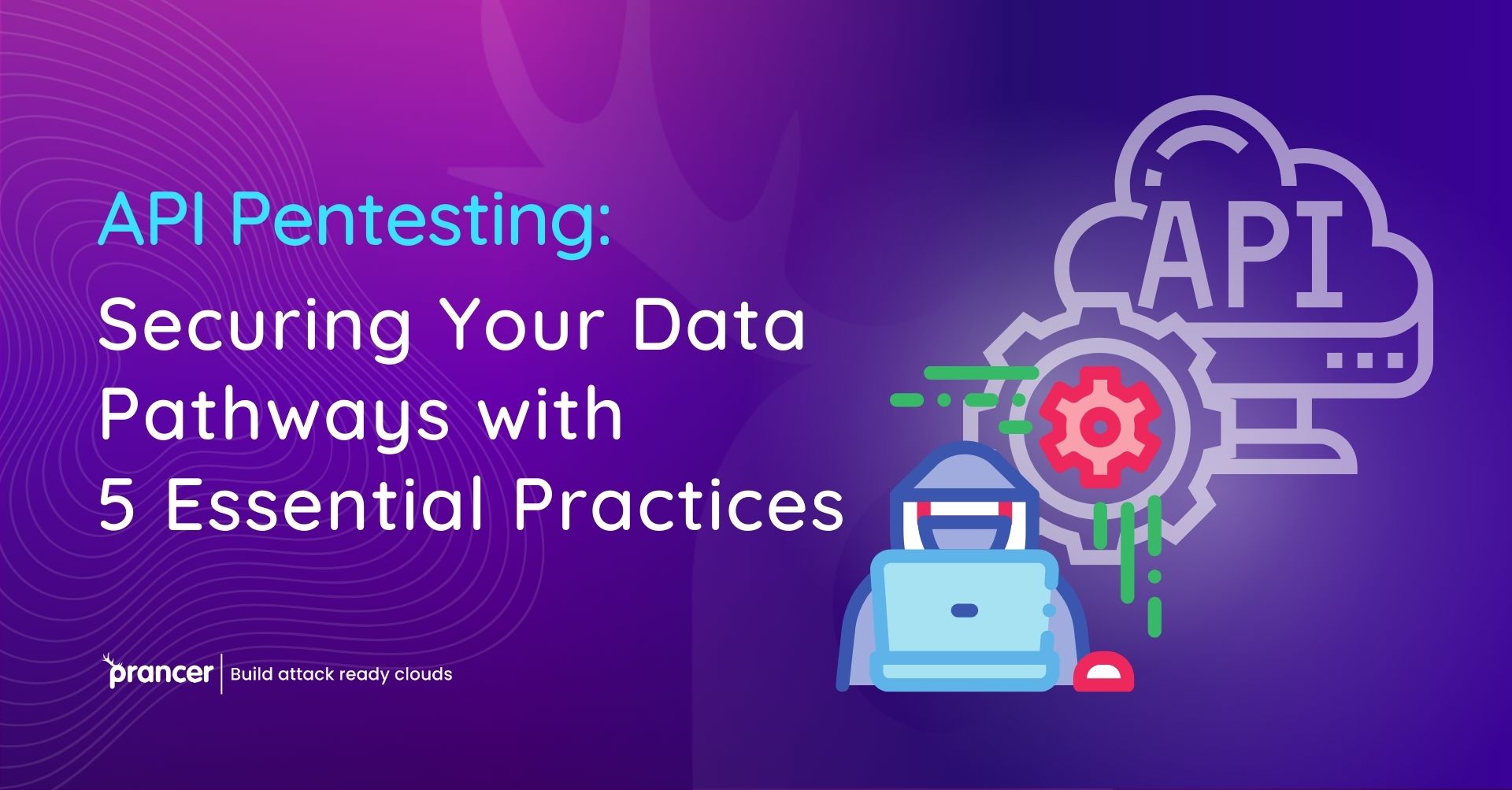

In the multifaceted domain of cybersecurity, where threats continually evolve, securing your data pathways is more than just a requirement; it’s an imperative. The increasing reliance on Application Programming Interfaces (APIs) underscores the significance of API pentesting in safeguarding your digital assets. Within this piece, we will dive into the pivotal practices and highlight the role of tools like Prancer and automated penetration testing in bolstering your data defenses.
What Is API Pentesting? API pentesting, also known as API penetration testing, stands at the forefront of cybersecurity strategies. It focuses on examining the robustness of APIs, seeking potential vulnerabilities and misconfigurations. The ultimate aim? Fortify your APIs against unauthorized breaches, data leaks, and cyber threats.
Why Prioritize API Pentesting? APIs act as the digital gateways facilitating data exchange across diverse software platforms. However, these gateways can be vulnerable. Engaging in API pentesting empowers organizations to:
Prancer‘s formidable capabilities make it indispensable in the realm of API pentesting:
The prowess of automated penetration testing tools lies in their ability to simulate cyber-attacks, yielding real-time vulnerability data. When intertwined with the capabilities of Prancer, these tools amplify API pentesting by:
With the changes happening in cybersecurity, API pentesting has emerged as important defense tactics with Prancer and automated testing taking center stage. This process is a detailed assessment of APIs to find and remedy weaknesses, protecting against unauthorized penetrations or leaks of data. Crucial components of this process involve the use tools like Prancer in detailed API endpoint mapping, thorough authentication and authorization verification and intensive input validation and injection testing to combat threats such as SQL injection a nd XSS. It is also critical to control data sensitivity via encryption and regulated access. In the field of API Pentesting, Prancer plays a significant role as it offers continuous monitoring and complete compliance with security protocols while sharing the efficient management capability to address vulnerabilities effectively so that APIs are well fortified against evolving landscape conditions related to cyber threats.
Automated API Security Analysis: Highlighting the importance of automated instruments such as Prancer in performing API analysis for security vulnerabilities, including wrong handling JSON/XML inputs and incorrect rate limiting APIs.
Enhanced API Security Protocols: Providing superior security facilities which have built in automated checks for popular flaws like broken object level authorization and broken user authentication.
Integration with API Development Lifecycle: Integrating automated penetration testing into the API creation value chain, setting up security checks as an ongoing CI/CD pipeline.
Custom Automated Testing Scenarios: Developing customized automated testing scenarios that mimic real-world cyberattacks based on the distinctive structures and use patterns of APIs.
Automated Security in Serverless API Environments: It gives attention to the safety of serverless APIs, specifically whether automated penetration testing tools examine for weaknesses in configurations and functions related to serverless.
Securing API Gateways with Automation: Automated penetration testing of API gateways, the review for misconfigurations and strong authentication & authorization mechanisms.
AI-Driven API Security Analysis: In using AI to analyze API traffic patterns and detect abnormalities that it predicts would lead a security breach before such an occurrence.
Automated Compliance Checks: While automated tools help ensure APIs follow regulatory standards, such as GDPR, HIPAA and OWASP API security recommendations.
Prancer’s Role in Continuous API Monitoring: Using Prancer for non-stop monitoring of APIs, ensuring that threats are identified in real time and prompt response to discovered vulnerabilities.
Automated Testing for Microservices and APIs: Resolving API security issues created by microservices architecture with automated penetration testing to secure all the APIs of individual microservice.
Cloud-Native API Security: Concentrating on the special needs of cloud-based APIs, such as computerized security evaluations for threats and vulnerabilities in clouds.
Enhancing API Security with Behavioral Analysis: Having operational automated behavioral analysis in place to comprehend the standard use of APIs and identify differences that might indicate a security concern.
Scalable Automated Penetration Testing: The ensuring of the scalability of automated penetration testing tools to cater for both the increasing number and intricacy APIs in massive systems.
Improving API Data Encryption Practices: Automated testing of and verification that encryption standards are correctly implemented within APIs to ensure the secure transmission and storage data.
Securing Third-Party API Integrations: Implementing automated penetration testing for third-party API integrations, evaluating the security status of external APIs interfacing with the system.
Utilizing Prancer for API Gateway Security: The use of Prancer to carry out automated security scans on API gateways; ensuring that they are correctly configured for prevention against unauthorized access and data breaches.
Automated Security Audits for API Updates: Through regular automated security audits whenever APIs are updated or new features are added, continuous protection is ensured.
Prancer’s Advanced Reporting Mechanisms: Using the powerful reporting feature of Prancer to provide detailed information on API vulnerabilities that will help guide making sound security decisions.
Automated API Security for IoT Devices: Widening the scope of automated penetration testing to IoT device APIs, tackling specific security issues found in IOT environments.
Collaborative API Security Improvement: Helping API security improvement together with shared insights and automated test results enhance the community’s approach to secure APIs.
Future-proofing API Security with Automation: Employing automated penetration testing methodologies that are constantly updated to respond the changing API technologies, emerging security threats while continuously evolving would ensure future-proof measures in terms of API protection.
Incorporating User Feedback in Automated Testing: Integration of the users feedback into developing automated penetration testing tools, such that they satisfy trends in API developers and security professionals needs.
Automated Penetration Testing for API Documentation Security: Integrating the automated tests into API documentation, ensuring that there are no leakage of confidential information or security holes.
Prancer’s Role in API Security Training: Through features such as the use of automated tools from Prancer and experience in identifying risks detected by these tools during API security training programs.
Enhancing API Security with Automated Threat Intelligence: Combining automated threat intelligence with API security plans, delivering real time updates on new threats and allowing organizations to act in advance.
Conclusion
To sum up, automated penetration testing is a key player in strengthening API security in the modern highly dynamic world of the cybersecurity. The likes of Prancer tools streamline this process, providing continuous monitoring, compliance assurance, and near-instant vulnerability remediation. An automated penetration testing can be part of the API lifecycle development process, by customizing testing scenarios organisation will be able to address a range of cyber threats proactively. Such approach does not just improve the stability of the APIs to possible breaches but also enforces them to meet the varying regulatory standards. Hence, automated penetration testing is not only a tool but a strategic friend in protecting the digital gateways of our era, securing data pathways and rebuilding trust in digital infrastructure.
the intricacies of API pentesting are not just another facet of cybersecurity; they’re a cornerstone. By integrating the five mentioned practices and harnessing the potential of Prancer, along with automated penetration testing tools, you’re crafting a formidable defense line. In this digital age, ensuring the sanctity of your assets and conforming to industry benchmarks is paramount, and API pentesting is your trusted ally on this journey.
